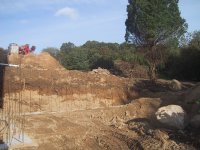I work a lot with piles of stuff like woodchip mulch, crushed rock, compost, etc., and I'm building a retaining wall as a backstop against which I can have 6 yards of these materials dumped at a time. I was going to use the 2'x2'x6' precast blocks, which are pretty cheap at the concrete plant but heavy and expensive to get here, so I'm pouring a concrete wall. I'll build cinder block walls to separate the bays when I figure out the optimum bay size. The photo is of one section of the retaining wall footing.
What should I put on the ground? I don't really want concrete, because some drainange would be desirable. But then I want to be able to scrape and push the piles around without digging up the ground and adding that to the piles. I was thinking of 6" packed crushed stone, under 4" of packed gravel. I've seen a gravel that really packs hard, but don't know what its called. And under the compost pile I'll probably just leave dirt, to make it easy for the worms.
What should I put on the ground? I don't really want concrete, because some drainange would be desirable. But then I want to be able to scrape and push the piles around without digging up the ground and adding that to the piles. I was thinking of 6" packed crushed stone, under 4" of packed gravel. I've seen a gravel that really packs hard, but don't know what its called. And under the compost pile I'll probably just leave dirt, to make it easy for the worms.

